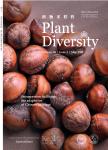Current re-vegetation patterns and restoration issues in degraded geological phosphorus-rich mountain areas:A synthetic analysis of Central Yunnan, SW China
Current re-vegetation patterns and restoration issues in degraded geological phosphorus-rich mountain areas:A synthetic analysis of Central Yunnan, SW China作者机构:Key Laboratory for Plant Diversity and Biogeography of East AsiaKunming Institute of BotanyChinese Academy of Sciences World Agroforestry CenterICRAF East and Central Asia The State Phosphorus Resource Development and Utilization Engineering Technology Research CentreYunnan Phosphate Chemical Group Co. Ltd College of Resource and EnvironmentYunnan Agricultural University
出 版 物:《Plant Diversity》 (植物多样性(英文版))
年 卷 期:2017年第39卷第3期
页 面:140-148页
核心收录:
学科分类:0710[理学-生物学] 0830[工学-环境科学与工程(可授工学、理学、农学学位)] 07[理学] 0901[农学-作物学] 0902[农学-园艺学] 0713[理学-生态学]
基 金:the support of the Chinese Academy of Sciences' Frontier Science Key Project (QYZDY-SSWSMC014) The Federal Ministry for Economic Cooperation and Development, Germany(#13.1432.7-001.00) Project funded by Yunnan Postdoctoral Science Foundation (Y732081261)
主 题:Systematic review Dianchi Lake Fuxian Lake Natural restoration Human engineered restoration Floristic similarity
摘 要:China has the largest area of inland geological phosphorus-rich(GPR) mountains in the world, where vegetation restoration is key to safeguarding the environment. We reviewed the published literature and collected new data in order to analyze re-vegetation patterns and the status of plant communities in central Yunnan. The aim of our analysis was to suggest future improvements to restoration strategies in GPR mountain regions. Our results showed that spontaneous recovery was the most widespread type of restoration. N-fixing species such as Coriaria nepalensis and Alnus nepalensis play a vital role in succession. In the past, monoculture tree plantation was the primary method used in afforestation activities in central Yunnan; in recent years however, several different methods of restoration have been introduced including the use of agroforestry systems. For practical restoration, we found that spontaneous recovery was capable of delivering the best results, but that during its early stages, restoration results were affected by several factors including erosion risk, the origin of propagates and environmental variation. In contrast, methods employing human-made communities performed better in their early stages, but were constrained by higher costs and vulnerability to degradation and erosion. The use of N-fixing species such as A. nepalensis and Acacia mearnsii in plantations were unsuccessful in restoring full ecosystem functions. The success of restoration activities in GPR mountain regions could be improved through the following measures:(1) developing a better understanding of the respective advantages and disadvantages of current natural and human-engineered restoration approaches;(2) elucidating the feedback mechanism between phosphorus-rich soil and species selected for restoration, especially N-fixing species;(3) introducing market incentives aimed at encouraging specific restoration activities such as agroforestry, and improving the industry value chain.



